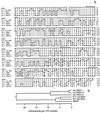The identification of a 9-cis retinol dehydrogenase in the mouse embryo reveals a pathway for synthesis of 9-cis retinoic acid
- PMID: 9539749
- PMCID: PMC22501
- DOI: 10.1073/pnas.95.8.4404
The identification of a 9-cis retinol dehydrogenase in the mouse embryo reveals a pathway for synthesis of 9-cis retinoic acid
Abstract
The ligand-controlled retinoic acid (RA) receptors and retinoid X receptors are important for several physiological processes, including normal embryonic development, but little is known about how their ligands, all-trans and 9-cis RA, are generated. Here we report the identification of a stereo-specific 9-cis retinol dehydrogenase, which is abundantly expressed in embryonic tissues known to be targets in the retinoid signaling pathway. The membrane-bound enzyme is a member of the short-chain alcohol dehydrogenase/reductase superfamily, able to oxidize 9-cis retinol into 9-cis retinaldehyde, an intermediate in 9-cis RA biosynthesis. Analysis by nonradioactive in situ hybridization in mouse embryos shows that expression of the enzyme is temporally and spatially well controlled during embryogenesis with prominent expression in parts of the developing central nervous system, sensory organs, somites and myotomes, and several tissues of endodermal origin. The identification of this enzyme reveals a pathway in RA biosynthesis, where 9-cis retinol is generated for subsequent oxidation to 9-cis RA.
Figures





Similar articles
-
Identification and characterization of a stereospecific human enzyme that catalyzes 9-cis-retinol oxidation. A possible role in 9-cis-retinoic acid formation.J Biol Chem. 1997 May 2;272(18):11744-9. doi: 10.1074/jbc.272.18.11744. J Biol Chem. 1997. PMID: 9115228
-
Characterization of human short chain dehydrogenase/reductase SDR16C family members related to retinol dehydrogenase 10.Chem Biol Interact. 2017 Oct 1;276:88-94. doi: 10.1016/j.cbi.2016.10.019. Epub 2016 Oct 25. Chem Biol Interact. 2017. PMID: 27793605 Free PMC article.
-
The visual cycle retinol dehydrogenase: possible involvement in the 9-cis retinoic acid biosynthetic pathway.FEBS Lett. 1998 May 29;428(3):135-40. doi: 10.1016/s0014-5793(98)00473-6. FEBS Lett. 1998. PMID: 9654122
-
Involvement of alcohol dehydrogenase, short-chain dehydrogenase/reductase, aldehyde dehydrogenase, and cytochrome P450 in the control of retinoid signaling by activation of retinoic acid synthesis.Biochemistry. 1996 Sep 24;35(38):12221-7. doi: 10.1021/bi961176+. Biochemistry. 1996. PMID: 8823154 Review.
-
The oxidation of 9-cis-retinol: a possible synthesis pathway for 9-cis-retinoic acid.Nutr Rev. 2000 Nov;58(11):354-6. doi: 10.1111/j.1753-4887.2000.tb01833.x. Nutr Rev. 2000. PMID: 11140907 Review.
Cited by
-
Dual-substrate specificity short chain retinol dehydrogenases from the vertebrate retina.J Biol Chem. 2002 Nov 22;277(47):45537-45546. doi: 10.1074/jbc.M208882200. Epub 2002 Sep 10. J Biol Chem. 2002. PMID: 12226107 Free PMC article.
-
In vivo activation of PPAR target genes by RXR homodimers.EMBO J. 2004 May 19;23(10):2083-91. doi: 10.1038/sj.emboj.7600209. Epub 2004 Apr 22. EMBO J. 2004. PMID: 15103326 Free PMC article.
-
Signaling through retinoic acid receptors in cardiac development: Doing the right things at the right times.Biochim Biophys Acta. 2015 Feb;1849(2):94-111. doi: 10.1016/j.bbagrm.2014.08.003. Epub 2014 Aug 15. Biochim Biophys Acta. 2015. PMID: 25134739 Free PMC article. Review.
-
Spatiotemporal retinoid-X receptor activation detected in live vertebrate embryos.Proc Natl Acad Sci U S A. 2004 Jun 15;101(24):8987-92. doi: 10.1073/pnas.0307053101. Epub 2004 Jun 3. Proc Natl Acad Sci U S A. 2004. PMID: 15178767 Free PMC article.
-
Activity of human 11-cis-retinol dehydrogenase (Rdh5) with steroids and retinoids and expression of its mRNA in extra-ocular human tissue.Biochem J. 1999 Feb 15;338 ( Pt 1)(Pt 1):23-7. Biochem J. 1999. PMID: 9931293 Free PMC article.
References
-
- Chambon P. FASEB J. 1996;10:940–954. - PubMed
-
- Mangelsdorf D J, Umesono K, Evans R M. In: The Retinoid Receptors. Sporn M B, Roberts A B, Goodman D S, editors. New York: Raven; 1994. pp. 319–349.
-
- Kastner P, Mark M, Ghyselinck N, Krezel W, Dupe V, Grondona J M, Chambon P. Development (Cambridge, UK) 1997;124:313–326. - PubMed
-
- Mangelsdorf D J, Evans R M. Cell. 1995;83:841–850. - PubMed
-
- Dollé P, Fraulob V, Kastner P, Chambon P. Mech Dev. 1994;45:91–104. - PubMed
Publication types
MeSH terms
Substances
Associated data
- Actions
LinkOut - more resources
Full Text Sources
Other Literature Sources
Molecular Biology Databases

